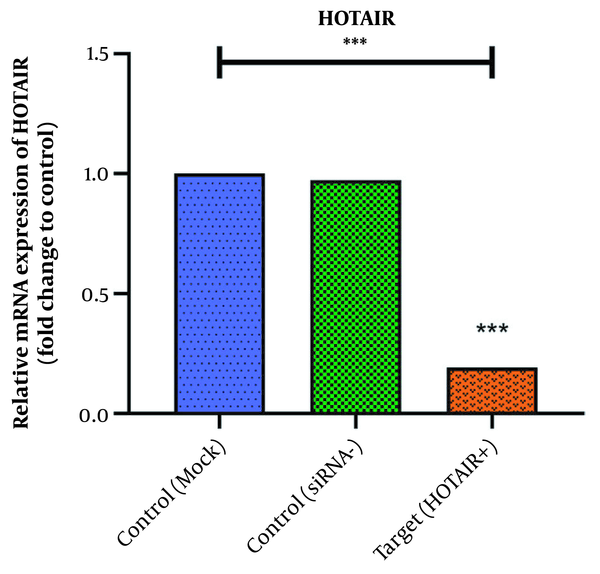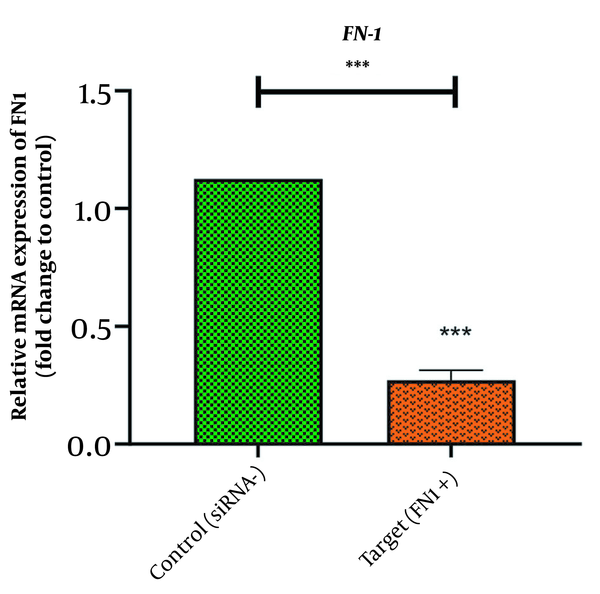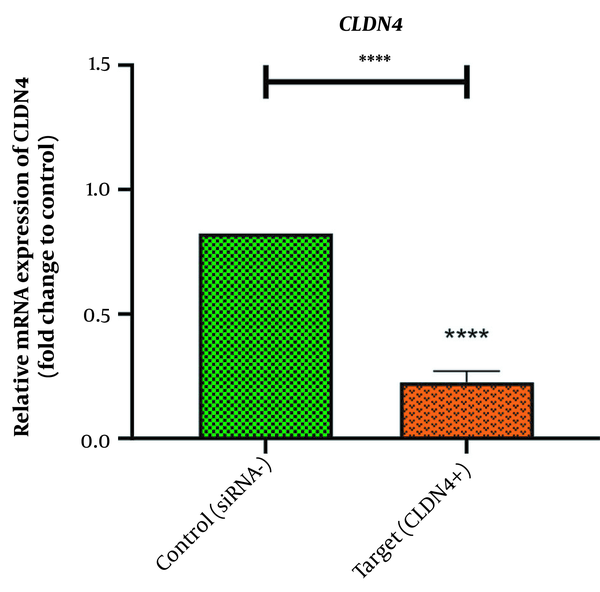Abstract
Background:
Gastric cancer is one of the most prevalent human malignancy-related death worldwide, which is usually diagnosed at the advanced stages resulting in metastasis. Recent studies have revealed that long non-coding RNAs (lncRNAs), which are known as non-coding RNAs, play a significant role in creating variety of molecular pathways (e.g., growth, proliferation, differentiation, and apoptosis) and negatively contribute to many unusual processes, including human cancers. The HOX antisense intergenic RNA (HOTAIR) is one of the novel non-coding RNAs which has recently emerged as a promoter of metastasis in different types of human cancers through epithelial-to-mesenchymal transition (EMT) process. Epithelial-to-mesenchymal transition (EMT) is a cellular process where an epithelial cell could change its phenotype to mesenchymal condition, which plays a crucial role in promoting cell invasion, angiogenesis, and metastases.Methods:
This study aimed to explore the effect of HOTAIR gene silencing on the expression levels of two main markers of EMT signaling pathway, fibronectin (FN1) and claudin4 (CLDN4) in MKN45 cellular model of gastric cancer. The MKN45 cells were subjected to HOTAIR specific siRNA for 48 hours, and the extracted RNAs were subjected to cDNA synthesis and real-time PCR. The expression change was calculated using 2-ΔΔct.Results:
Our findings showed that FN1 and CLDN4 were upregulated in MKN45 cells. Following the transfection of cell by HOTAIR siRNA, both FN1 and CLDN4 genes were significantly downregulated.Conclusions:
HOTAIR long non-coding RNA may have regulated the expression levels of FN1 and CLDN4 genes in EMT signaling pathway. However, it was recommended that further experimental analyses should be carried out to confirm this observation. In other word, our study result may not have been applied as a therapeutic access until additional experiments were conducted.Keywords
Long Non-coding RNA HOTAIR Gastric Cancer EMT Fibronectin1 Claudin4 MKN45
1. Background
Gastric cancer (CG) is one the most common cancers worldwide, which is usually diagnosed at late stage since it is asymptomatic in early stages (1, 2). Tumor resection and surgery are the only effective strategies to treat it, while chemotherapy has proven ineffective in this regard (3). Molecular targeted therapies of cancers have been proposed in recent decades as alternative treatment methods. However, it is necessary to identify the involved molecular pathways before designing novel and specific therapeutics methods for each cancer (4).
Long non-coding RNAs (lncRNAs) are defined as lengthy transcripts (larger than 200 nt) lacking protein-coding capacity (5). The involvement of lncRNAs in broad spectrum of biological processes such as cell cycle, growth, differentiation, and apoptosis has been reported (6). Aberrant expressions of lncRNAs have been found in a variety of human tumors, suggesting that these non-coding transcripts are potential biomarkers of cancers (7). The HOX antisense intergenic RNA (HOTAIR) is an oncogenic lncRNAs playing a critical role in promotion, progression, and invasion of variety of human cancers (8). The involvement is well-defined and established (9). It has been reported that silencing of HOTAIR exerts an anti-tumor effect on gastric cancer and potentially inhibits cell growth (10). Epithelial-mesenchymal transition (EMT) is a cellular process whereby epithelial cells lose their characteristics and obtain mesenchymal phenotypes. Following EMT, epithelial cells lose cell-cell joints, polarity, and epithelial markers, and then non-motile epithelial cells gain cell motility, a spindle-cell shape, and presenting mesenchymal markers (11). Epithelial-mesenchymal transition trigger the cancer metastatic cascade through different signaling pathways (12). Claudins are structural and functional elements of tight junction playing an important role during EMT (13). Dysregulation expression of claudins has been reported in several human tumors, and the pattern depends on claudins isoform or cancer type (14). Loss of function of these proteins affect the cell-cell adhesions and prepare the cellular micro environment toward malignant transformation (15). Fibronectin (FN) is an abundant extracellular matrix (ECM) glycoprotein that functions during tissue repair (16). Altered expression of fibronectin in various human tumors proposed them as promoters of cancer progression and metastasis (17).
2. Objectives
Accordingly, the present study aimed to investigate the effect of HOTAIR long non-coding RNA on expression levels of the fibronectin-1 and claudin-4 adopting siRNA strategy.
3. Methods
The present study was extracted from M.Sc. thesis written by S.A., which was approved by Ethical Committee of Islamic Azad University Tehran Medical Sciences, Research Affairs, Tehran, Iran. University (codding number and code of ethics: IR.IAU.PS.REC.1401.122).
3.1. Cell Lines and Culture Condition
The MKN45 cell line was used as cellular model of human gastric adenocarcinoma. Cells were purchased from national cell bank of the Pasteur Institute, Tehran, Iran. The cells were cultured in Dulbecco's modified eagle medium (DMED) (Life Technologies, USA) supplemented with 10% heat inactivated fetal bovine serum (FBS), 100 U/mL penicillin, and 100 mg/mL streptomycin antibiotics (Life Technologies, USA). The cells were maintained at 37°C in a humidified atmosphere of 5% CO2. The MKN45 cells were sub-cultured every 2 - 3 days.
3.2. HOTAIR siRNA Transfection
HOTAIR specific-siRNA was purchased from (Gene Pharma, China) with product ID number: 100,124,700. The siRNA sequences were: HOTAIR:5'UAACAAGACCAGAGAGCUGUU-3', negative control: 5'-TTCTCCGAACGTGTCACGT-3'.
The MKN45 cells were plated in 12-well plates (12 × 104 cell/well) and transfected by 50 ng siRNA duplexes through lipofectamine 2000 (Invitrogen, USA) according to manufacturer's protocol. The cells following the transfection process with no siRNA was considered as mock-treated cells. The cells were subjected to RNA extraction after 48 h post-treatment with siRNA.
3.3. RNA Extraction and cDNA Synthesis
Total RNA was extracted from MKN45 cells by RNX-plus solution using product guideline (SinaClon, Iran). The RNAs were treated with DNaseI (Thermo Fisher Scientific, USA) to prevent genomic DNA contamination. PrimeScriptTM RT kit (Takara, Japan) was used to synthesize cDNA. The primers used in this study are presented in Table 1.
The Primer Sequences of HOTAIR, FN1, CLDN4, and GAPDH
| Primer | Forward Sequence 5'-3' | Reverse Sequence 5'-3' | Amplicon Size (bp) |
|---|---|---|---|
| HOTAIR | AGGCCCTGCCTTCTGCCT | TGCTCTCTTACCCCCACGGA | 147 |
| FN1 | GCAACTCTGTCAACGAAGG | TTCCAAAGCCTAAGCACTG | 147 |
| CLDN4 | CATCATCAGCATCATCGTGG | GGCACTATCACCATAAGGC | 153 |
| GAPDH | GTGAACCATGAGAAGTATGACAAC | CATGAGTCCTTCCACGATACC | 123 |
3.4. Real Time Polymerase Chain Reaction
Real-time-PCR was performed using SYBR green Premix Ex TaqTM II kit (Takara, Japan), and the data were analyzed using Livak equation (2-∆∆Ct method).
3.5. Statistical Analysis
Statistical analysis was carried out using Prism® 8 software (GraphPad Software, Inc, La Jolla, CA, USA), and the data were analyzed using one-way analysis of variance followed by Newman-Keuls multiple comparison test or student's t-test. Differences among groups were considered statistically significant when P < 0.05. The data were shown as mean ± standard deviation.
4. Results
To evaluate the efficacy of the employed siRNA, the expression of HOTAIR was measured using real-time PCR. As indicated in Figure 1, the expression level of HOTAIR was high in MKN45 cancer cells. After 48h transfection with its specific siRNA, the expression levels of this lncRNA were significantly reduced (P-value < 0.001). The fold change was calculated as 0.191 ± 0.039. This data showed that the siRNA had acted successfully.
Silencing HOTAIR expression after 48 h post-treatment with 50 ng of siRNA (the results are shown as mean ± SD, and the *** shows P < 0.001).

In the same vain, the expression levels of CLDN4 and FN1 were well-quantified with real-time PCR in order for addressing the possibility of the changes, triggered by silenced HOTAIR, in the expression levels of these EMT genes. Our observation revealed that FN1 and CLDN4 were remarkably transcribed in MKN45 cell lines (Figures 2 and 3). However, the treatment with HOTAIRs siRNA downregulated the expression of FN1 (Figure 2) and CLDN4 (Figure 3). The CLDN4 and FN1 fold-changes were 0.225 ± 0.0451(P-value < 0/0001) and 0.271 ± 0.0432 (P-value < 0/001), respectively. This meant that FN1 gene was downregulated three times, and CLDN4 gene was reduced four times after transfection.
The effects of HOTAIR silencing on expression of FN1 after 48 h post-treatment with 50 ng siRNA (data are shown as mean ± SD, and the *** shows P < 0.001).

The effects of HOTAIR silencing on expression of CLDN4 after 48 h post-treatment with 50 ng siRNA (data are shown as mean ± SD, and the **** shows P < 0.0001).

5. Discussion
To our knowledge, the present study was the first to show the effect of HOTAIR silencing on expression levels of the two EMT markers, called fibrinectin-1 and claudin-4, in cellular model of gastric adenocarcinoma (MKN45). The obtained data indicated that both markers were significantly downregulated after silencing of HOTAIR.
The role of EMT in occurrence of cancer invasion has been repeatedly confirmed by previous studies suggesting that this pathway is a molecular target of cancer remedy (18). It is worth noting that cancer-associated mortalities are due to metastatic tumors rather than primary ones (19).
Fibrinectin-1 (FN1) plays an important role in cell adhesion, cell growth, migration, and differentiation (20). This glycoprotein mediates the interaction between cells and extracellular matrix (21). High expression of fibrinectin-1 has been observed in several cancers, such as gastric and thyroid cancers, suggesting that it may play a role during cancer progression and invasion (20, 22). Silencing of fibrinectin-1 results in cell growth arrest and proliferation (23). In a study by Liu et al., the knockdown of HOTAIR was discovered to prevent E-cadherin reduction and inhibit fibronectin upregulation, which suggested that HOTAIR triggered the EMT program (24).
Similarly, Padua Alves et al. demonstrated that the fibronectin expression level was downregulated, while HOTAIR was silenced in breast cancer (25). Babapour et al. determined that silencing the long non-coding RNA HOTAIR suppressed EMT in AGS gastric cancer cell line by downregulating fibronectin 1 (26). HOTAIR has also been detected to reduce transcription level of the metastasis-associated genes like fibronectin (27).
Claudins are located in tight junctions of epithelial cells regulating the exchange of particles in the intercellular space between these cells (28).
Altered expression of claudins has been documented in various cancers (29). There is a growing body of evidence that claudins have considerable clinical significance and promising utility in diagnosis, prognosis, and treatment of human cancers (30). Dysfunctioning of claudins and other tight junction proteins in cancer has been recognized by previous studies as a mechanism for the loss of cell adhesion, an important step in the progression of cancer to metastasis (31). Claudins can act as either oncogene or tumor suppressors depending on claudins isoforms and cancer type (32). Among different isoforms of claudins, CLDN4 has not received enough research attention. Increased expression of CLDN4 has been found to be associated with tumor invasion and metastasis in gastric cancer (33). Silencing claudins induces apoptosis in several cancers (34). According to Babapour et al., silencing the long non-coding RNA HOTAIR suppresses EMT in AGS gastric cancer cell line by downregulating claudin-4 (26).
5.1. Conclusions
In sum, our novel finding confirmed that HOTAIR silencing downregulated the expression levels of both important markers of EMT genes, namely CLND4 and FN1. However, it was recommended that further investigations should be carried out in this regard.
References
-
1.
Wan QS, Zhang KH. Noninvasive detection of gastric cancer. Tumour Biol. 2016;37(9):11633-43. [PubMed ID: 27381515]. https://doi.org/10.1007/s13277-016-5129-4.
-
2.
Biondi A, Persiani R, Cananzi F, Zoccali M, Vigorita V, Tufo A, et al. R0 resection in the treatment of gastric cancer: room for improvement. World J Gastroenterol. 2010;16(27):3358-70. [PubMed ID: 20632437]. [PubMed Central ID: PMC2904881]. https://doi.org/10.3748/wjg.v16.i27.3358.
-
3.
Moses C, Garcia-Bloj B, Harvey AR, Blancafort P. Hallmarks of cancer: The CRISPR generation. Eur J Cancer. 2018;93:10-8. [PubMed ID: 29433054]. https://doi.org/10.1016/j.ejca.2018.01.002.
-
4.
Korfer J, Lordick F, Hacker UT. Molecular Targets for Gastric Cancer Treatment and Future Perspectives from a Clinical and Translational Point of View. Cancers (Basel). 2021;13(20):5216. [PubMed ID: 34680363]. [PubMed Central ID: PMC8533881]. https://doi.org/10.3390/cancers13205216.
-
5.
Heery R, Finn SP, Cuffe S, Gray SG. Long Non-Coding RNAs: Key Regulators of Epithelial-Mesenchymal Transition, Tumour Drug Resistance and Cancer Stem Cells. Cancers (Basel). 2017;9(4):38. [PubMed ID: 28430163]. [PubMed Central ID: PMC5406713]. https://doi.org/10.3390/cancers9040038.
-
6.
Castro-Oropeza R, Melendez-Zajgla J, Maldonado V, Vazquez-Santillan K. The emerging role of lncRNAs in the regulation of cancer stem cells. Cell Oncol (Dordr). 2018;41(6):585-603. [PubMed ID: 30218296]. https://doi.org/10.1007/s13402-018-0406-4.
-
7.
Wu P, Mo Y, Peng M, Tang T, Zhong Y, Deng X, et al. Emerging role of tumor-related functional peptides encoded by lncRNA and circRNA. Mol Cancer. 2020;19(1):22. [PubMed ID: 32019587]. [PubMed Central ID: PMC6998289]. https://doi.org/10.1186/s12943-020-1147-3.
-
8.
Dashtbozorgi R, Tahmasebi-Birgani M, Hajjari MR, Emami Razavi A. Silencing of HOTAIR Induced Apoptosis in Human Colorectal Cancer Cells through Up-regulation of Bax and Down-regulation of Bcl2. Jentashapir J Cell Mol Biol. 2021;12(4). e116108. https://doi.org/10.5812/jjcmb.116108.
-
9.
Endo H, Shiroki T, Nakagawa T, Yokoyama M, Tamai K, Yamanami H, et al. Enhanced expression of long non-coding RNA HOTAIR is associated with the development of gastric cancer. PLoS One. 2013;8(10). e77070. [PubMed ID: 24130837]. [PubMed Central ID: PMC3795022]. https://doi.org/10.1371/journal.pone.0077070.
-
10.
Chao P, Yongheng F, Jin Z, Yu Z, Shiyong Y, Kunxing Y, et al. lncRNA HOTAIR knockdown suppresses gastric cancer cell biological activities. Food Sci Nutr. 2021;9(1):123-34. [PubMed ID: 33473276]. [PubMed Central ID: PMC7802579]. https://doi.org/10.1002/fsn3.1970.
-
11.
Lai X, Li Q, Wu F, Lin J, Chen J, Zheng H, et al. Epithelial-Mesenchymal Transition and Metabolic Switching in Cancer: Lessons From Somatic Cell Reprogramming. Front Cell Dev Biol. 2020;8:760. [PubMed ID: 32850862]. [PubMed Central ID: PMC7423833]. https://doi.org/10.3389/fcell.2020.00760.
-
12.
Wu Y, Zhou BP. New insights of epithelial-mesenchymal transition in cancer metastasis. Acta Biochim Biophys Sin (Shanghai). 2008;40(7):643-50. [PubMed ID: 18604456]. [PubMed Central ID: PMC2740620]. https://doi.org/10.1111/j.1745-7270.2008.00443.x.
-
13.
Stebbing J, Filipovic A, Giamas G. Claudin-1 as a promoter of EMT in hepatocellular carcinoma. Oncogene. 2013;32(41):4871-2. [PubMed ID: 23318416]. https://doi.org/10.1038/onc.2012.591.
-
14.
Li J. Dysregulated expression of claudins in cancer. Oncol Lett. 2021;22(3):641. [PubMed ID: 34386063]. [PubMed Central ID: PMC8298996]. https://doi.org/10.3892/ol.2021.12902.
-
15.
Sheehan GM, Kallakury BV, Sheehan CE, Fisher HA, Kaufman Jr RP, Ross JS. Loss of claudins-1 and -7 and expression of claudins-3 and -4 correlate with prognostic variables in prostatic adenocarcinomas. Hum Pathol. 2007;38(4):564-9. [PubMed ID: 17306334]. https://doi.org/10.1016/j.humpath.2006.11.007.
-
16.
To WS, Midwood KS. Plasma and cellular fibronectin: distinct and independent functions during tissue repair. Fibrogenesis Tissue Repair. 2011;4:21. [PubMed ID: 21923916]. [PubMed Central ID: PMC3182887]. https://doi.org/10.1186/1755-1536-4-21.
-
17.
Lin TC, Yang CH, Cheng LH, Chang WT, Lin YR, Cheng HC. Fibronectin in Cancer: Friend or Foe. Cells. 2019;9(1):27. [PubMed ID: 31861892]. [PubMed Central ID: PMC7016990]. https://doi.org/10.3390/cells9010027.
-
18.
Yilmaz M, Christofori G. EMT, the cytoskeleton, and cancer cell invasion. Cancer Metastasis Rev. 2009;28(1-2):15-33. [PubMed ID: 19169796]. https://doi.org/10.1007/s10555-008-9169-0.
-
19.
Lambert AW, Pattabiraman DR, Weinberg RA. Emerging Biological Principles of Metastasis. Cell. 2017;168(4):670-91. [PubMed ID: 28187288]. [PubMed Central ID: PMC5308465]. https://doi.org/10.1016/j.cell.2016.11.037.
-
20.
Sun Y, Zhao C, Ye Y, Wang Z, He Y, Li Y, et al. High expression of fibronectin 1 indicates poor prognosis in gastric cancer. Oncol Lett. 2020;19(1):93-102. https://doi.org/10.3892/ol.2019.11088.
-
21.
Pankov R, Yamada KM. Fibronectin at a glance. J Cell Sci. 2002;115(Pt 20):3861-3. [PubMed ID: 12244123]. https://doi.org/10.1242/jcs.00059.
-
22.
Sponziello M, Rosignolo F, Celano M, Maggisano V, Pecce V, De Rose RF, et al. Fibronectin-1 expression is increased in aggressive thyroid cancer and favors the migration and invasion of cancer cells. Mol Cell Endocrinol. 2016;431:123-32. [PubMed ID: 27173027]. https://doi.org/10.1016/j.mce.2016.05.007.
-
23.
Wang JP, Hielscher A. Fibronectin: How Its Aberrant Expression in Tumors May Improve Therapeutic Targeting. J Cancer. 2017;8(4):674-82. [PubMed ID: 28367247]. [PubMed Central ID: PMC5370511]. https://doi.org/10.7150/jca.16901.
-
24.
Liu YW, Sun M, Xia R, Zhang EB, Liu XH, Zhang ZH, et al. LincHOTAIR epigenetically silences miR34a by binding to PRC2 to promote the epithelial-to-mesenchymal transition in human gastric cancer. Cell Death Dis. 2015;6(7). e1802. [PubMed ID: 26136075]. [PubMed Central ID: PMC4650715]. https://doi.org/10.1038/cddis.2015.150.
-
25.
Padua Alves C, Fonseca AS, Muys BR, de Barros EBR, Burger MC, de Souza JE, et al. Brief report: The lincRNA Hotair is required for epithelial-to-mesenchymal transition and stemness maintenance of cancer cell lines. Stem Cells. 2013;31(12):2827-32. [PubMed ID: 24022994]. https://doi.org/10.1002/stem.1547.
-
26.
Babapour P, Tahmasebi-Birgani M, Hashemi M, Hajjari M. Silencing of Long Non-coding RNA HOTAIR Suppresses Reverses Epithelial-Mesenchymal Transition in AGS Gastric Cancer Cell Line by Downregulation of Fibronectin 1 and Claudin-4. Jentashapir J Cell Mol Biol. 2021;12(3). e116396. https://doi.org/10.5812/jjcmb.116396.
-
27.
Li T, Liu N, Gao Y, Quan Z, Hao Y, Yu C, et al. Long noncoding RNA HOTAIR regulates the invasion and metastasis of prostate cancer by targeting hepaCAM. Br J Cancer. 2021;124(1):247-58. [PubMed ID: 33024272]. [PubMed Central ID: PMC7782544]. https://doi.org/10.1038/s41416-020-01091-1.
-
28.
Lal-Nag M, Morin PJ. The claudins. Genome Biol. 2009;10(8):235. [PubMed ID: 19706201]. [PubMed Central ID: PMC2745760]. https://doi.org/10.1186/gb-2009-10-8-235.
-
29.
Singh AB, Sharma A, Dhawan P. Claudin family of proteins and cancer: an overview. J Oncol. 2010;2010:541957. [PubMed ID: 20671913]. [PubMed Central ID: PMC2910494]. https://doi.org/10.1155/2010/541957.
-
30.
Iravani O, Tay BW, Chua PJ, Yip GW, Bay BH. Claudins and gastric carcinogenesis. Exp Biol Med (Maywood). 2013;238(4):344-9. [PubMed ID: 23759999]. https://doi.org/10.1177/1535370213477981.
-
31.
Higashi Y, Suzuki S, Sakaguchi T, Nakamura T, Baba S, Reinecker HC, et al. Loss of claudin-1 expression correlates with malignancy of hepatocellular carcinoma. J Surg Res. 2007;139(1):68-76. [PubMed ID: 17270214]. https://doi.org/10.1016/j.jss.2006.08.038.
-
32.
Tabaries S, Siegel PM. The role of claudins in cancer metastasis. Oncogene. 2017;36(9):1176-90. [PubMed ID: 27524421]. https://doi.org/10.1038/onc.2016.289.
-
33.
Shang X, Lin X, Alvarez E, Manorek G, Howell SB. Tight junction proteins claudin-3 and claudin-4 control tumor growth and metastases. Neoplasia. 2012;14(10):974-85. [PubMed ID: 23097631]. [PubMed Central ID: PMC3479841]. https://doi.org/10.1593/neo.12942.
-
34.
Liu W, Li M. The role of claudin-4 in the development of gastric cancer. Scand J Gastroenterol. 2020;55(9):1072-8. [PubMed ID: 32715822]. https://doi.org/10.1080/00365521.2020.1795923.
